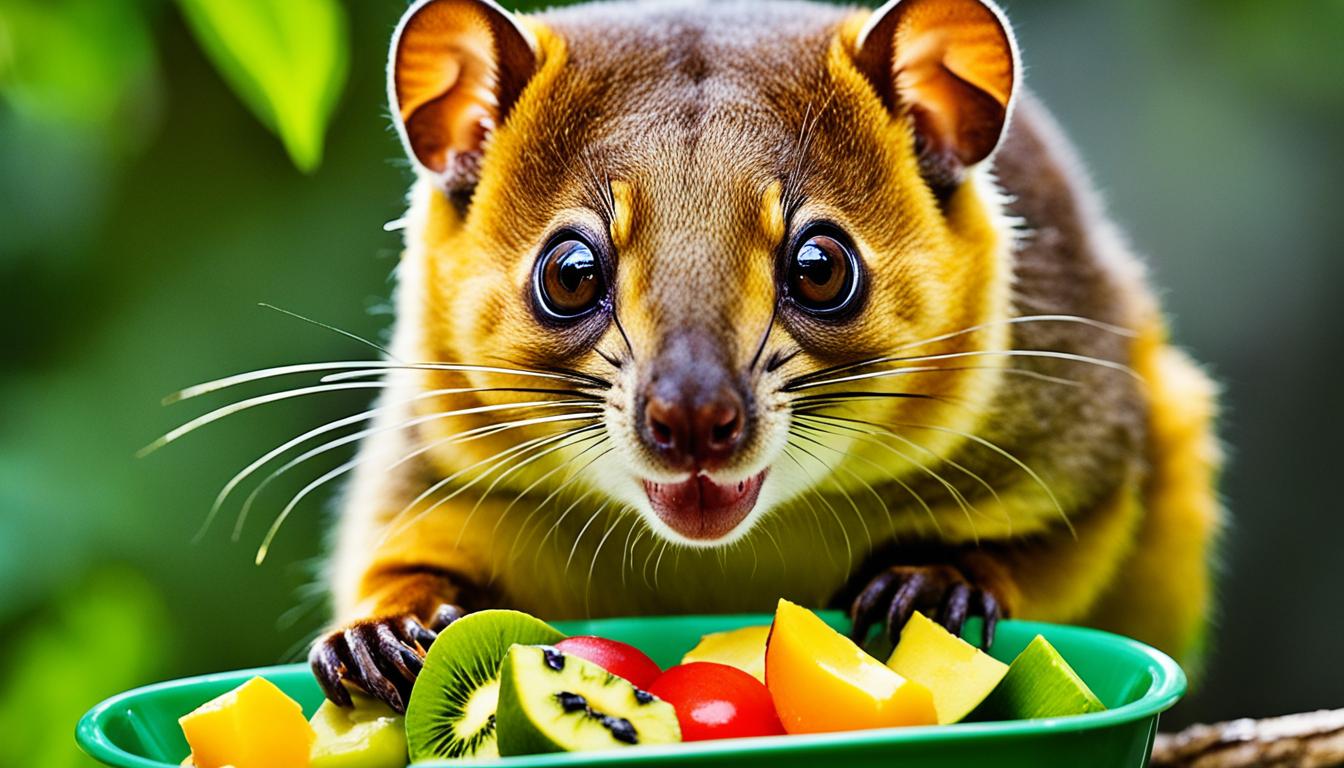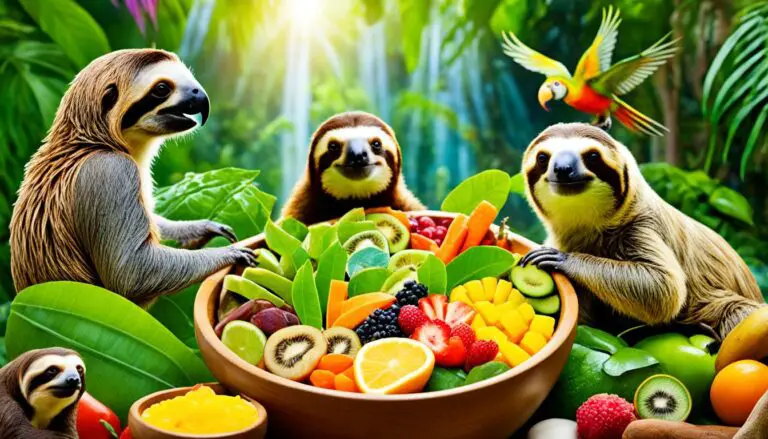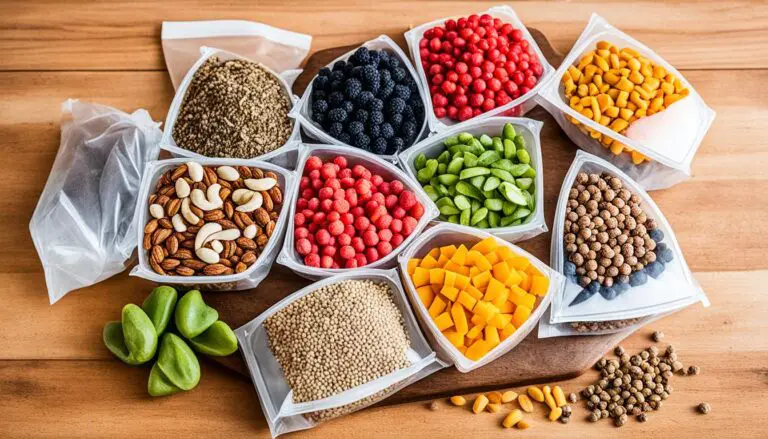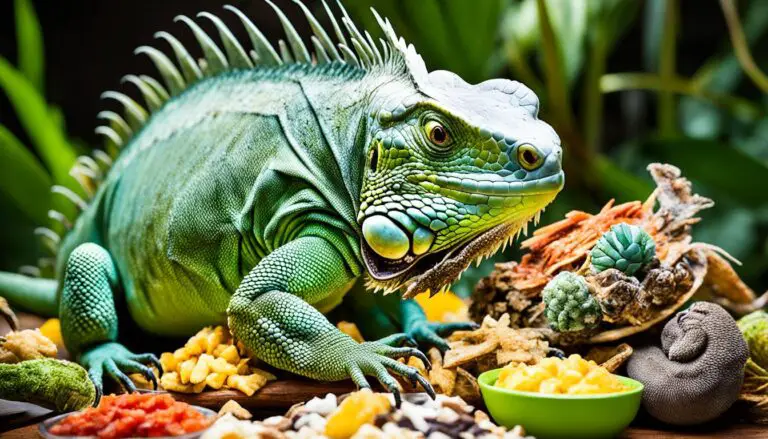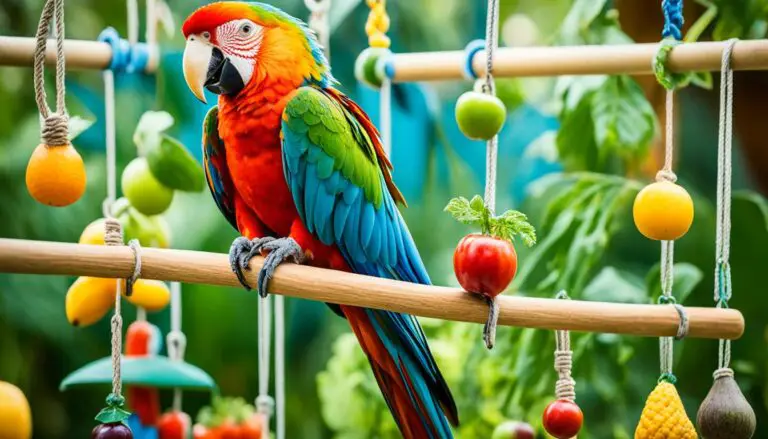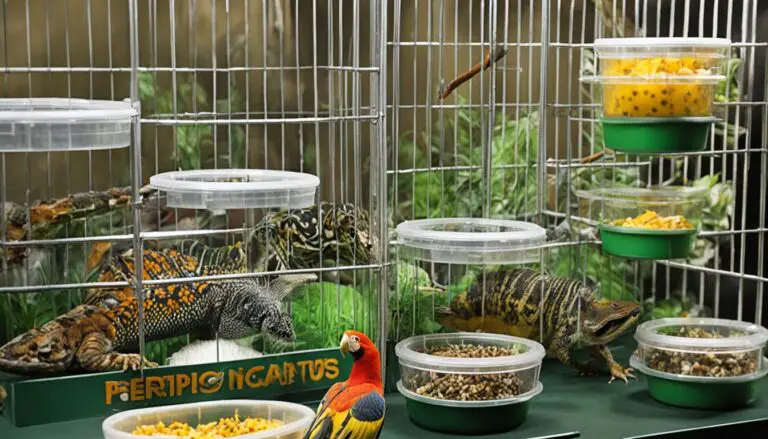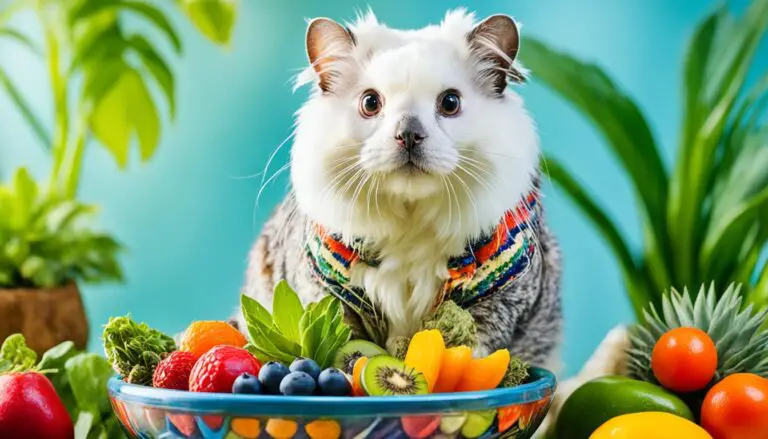Species-Specific Diets for Exotic Pets Like Kinkajou
Kinkajous are exotic pets that many don’t know much about. They need special diets to stay healthy and full of energy. Part of the raccoon family, they live in the treetops of rainforests in Central and South America. Knowing what to feed them is key to caring for them well.
It’s important to mimic what they would eat in the wild. This involves detailed diet plans that match their natural food. With the right food, kinkajous can be happy and healthy in our homes.
Key Takeaways:
- Formulating species-specific diets is crucial for the health and vitality of exotic pets like kinkajous.
- Kinkajous belong to the family Procyonidae and are primarily found in the canopies of neotropical primary rainforests.
- Understanding the dietary requirements of kinkajous is essential for their proper care and well-being.
- By formulating well-balanced diets that replicate their natural food sources, kinkajous can thrive in captivity.
- Consulting with professionals and staying updated on best practices is vital for responsible kinkajou ownership.
Natural History and Feeding Behavior of Kinkajous
Kinkajous are arboreal creatures from the top of neotropical rainforests. They have special diets that must be considered in captivity. To develop the right diet for them, we need to know about their natural life and how they eat.
In the wild, these animals mainly eat fruit, along with some nectar and leaves. This diet gives them important nutrients and water. They also eat a small amount of insects to get protein.
When they eat, kinkajous can hang upside down to reach fruits and flowers. This allows them to access water-rich foods and helps in plant pollination.
“Kinkajous use their nimble hands and long tongues to get nectar and eat a variety of fruits. This shows how they have clever feeding ways.”
Knowing how kinkajous eat in the wild helps us create good diets for them in captivity. We mimic their natural eating habits by giving them many different fruits, plants, and some protein. This way, we can keep them healthy and live longer.

Nutrient and Energy Requirements of Kinkajous
When we make diets for kinkajous, knowing what they need is key. We look at their body design, their wild diet, and what their close relatives eat. This helps us understand what kinkajous should be fed.
Kinkajous have a simple gut that doesn’t work like others that eat plants. They don’t have a cecum to help break down tough plant parts. Also, they don’t need as much food energy as other animals their size.
We figure out what kinkajous should eat by looking at domestic dogs. We also check out certain primates that eat similar things. This helps create a good food plan for these unusual pets.
Gastrointestinal Tract Anatomy
Kinkajous’ stomach and guts are set up for handling certain foods. They don’t have some parts that help ferment hard-to-digest items. Because of this, they might not need as much rough plant food as other animals do.
Nutrient Content of Natural Diet
In the wild, kinkajous munch mostly on fruits, nectar, and leaves. This diet gives them the energy they need for their day. They also eat some bugs which help with their protein needs.
Nutrient Requirements of Similar Species
We look at the food needs of dogs and similar primates to guess what kinkajous might need. This gives us a good starting point to plan their meals.
| Nutrient | Requirement (per day) |
|---|---|
| Protein | 25-30% |
| Fat | 15-20% |
| Carbohydrates | 50-55% |
| Fiber | 10-15% |
| Vitamins and Minerals | Varied, sourced from fruits and vegetables |
These daily food needs are just starting points. Your kinkajou’s age, baby-making, and how active it is matter. A vet who knows exotic pets can help make a perfect food plan.

The Importance of Balancing Diets for Kinkajous
Kinkajous in captivity need a balanced and natural diet. Many diets for them are not good and could harm their health. It’s key to mix proper foods with some incomplete ones like certain fruits and bugs. This mix makes sure the kinkajous get all they need without too much of the wrong stuff.
Dietary Recommendations for Kinkajou Health and Longevity
Keeping kinkajous healthy needs us to think about what they eat. It’s important to feed them well. A good, varied diet keeps kinkajous strong and stops health problems. This is how we can make sure our pets live a long, happy life.
Life Stage-Specific Diet
Kinkajous’ diets change as they grow older. What they eat as babies is not what they need when they’re adults or seniors. Each stage needs its own special food to keep them healthy.
- Juvenile kinkajous: Young kinkajous need lots of good food to grow right. They should eat foods rich in protein, vitamins, and minerals. This helps their bones and muscles grow strong.
- Adult kinkajous: Adults need a balanced diet to stay healthy and full of energy.
- Senior kinkajous: As kinkajous get older, they slow down. They might need to eat less but still get important nutrients for their health.
Preventing Obesity
Obesity, or being too overweight, is a big problem for kinkajous. It can cause serious health issues. To keep them from getting too heavy, watch what they eat. Make sure they don’t eat too much.
It’s also key to keep your kinkajou moving and thinking with fun activities. This helps prevent obesity and keeps them happy.
<!– –>
–>
Feeding Guide for Kinkajous
Variety is important in a kinkajou’s diet. We need to think about what they would eat in the wild. Include different foods to make sure they get all the nutrients they need.
| Food Group | Percentage of Diet | Examples |
|---|---|---|
| Fruits and Vegetables | 80% | Mangoes, bananas, papayas, avocados, carrots, leafy greens |
| Proteins, Dry Foods, Nectar, and Treats | 20% | Commercial kinkajou food, freeze-dried insects, cooked chicken, hard-boiled eggs, natural nectars |
Always check with an animal nutrition expert when planning your kinkajou’s diet. They will make sure your pet gets all the right nutrients.
“A well-balanced diet is key to maintaining your kinkajou’s health and promoting a long and fulfilling life.” – Dr. Emily Martinez, Exotic Animal Veterinarian
Feeding Guidelines for Kinkajous in Captivity
A balanced diet is key to keeping kinkajous healthy in captivity. They need 80% fruits and veggies, and 20% proteins, dry foods, nectars, and treats. Variety is essential to meet their dietary needs and mirror their wild diet.
Fruits and vegetables loaded with vitamins and minerals are great for kinkajous. They should eat foods like bananas, apples, and leafy greens. Including a variety of foods keeps them healthy and happy.
Proteins are vital for kinkajous too. They should have lean meats like chicken and eggs for amino acids. Nectars or special kinkajou diets can also add essential nutrients to their meals.
Special Considerations for Dental Hygiene
Don’t forget about their teeth. Kinkajous can chew on hard veggies, freeze-dried meats, and chew toys. These help keep their teeth strong and healthy.
Replicating Natural Foraging Activities
Make feeding time mimic their wild foraging. Scatter food around their space or use puzzle feeders. This keeps them mentally and physically active.

| Food Group | Recommended Percentage |
|---|---|
| Fruits | 40% |
| Vetdinedertables | 40% |
| Proteins and Dry Foods | 15% |
| Nectars and Treats | 5% |
Understanding Kinkajou Weight and Body Condition
Keeping kinkajous at a healthy weight is key for their health. Their bodies work in unique ways. So, we need to plan their meals carefully. This ensures they get what they need without too much or too little.
A good diet is vital for a kinkajou’s weight and health. We must watch what and how much they eat. This stops them from getting too fat or too thin.
To plan a kinkajou’s diet, we look at what they naturally eat and what their bodies need. A balanced diet keeps them healthy. It’s all about giving them the right kinds and amounts of food.
Monitoring Kinkajou Weight and Body Condition
It’s important to check a kinkajou’s weight and health often. They need the right food to stay in shape. A vet who knows about these special pets can help. They’ll set a good start point for us to look back on.
Since kinkajous’ bodies work differently, we must watch their weight with care. We aim for steady, healthy weights over time.
But, weight isn’t the only thing to watch. A good kinkajou diet keeps their body just right. They should have the right amount of fat and strong muscles.
“Watching a kinkajou’s weight and health helps us change their diet as needed. Work with a vet for the best advice.”
Proper Diet Planning for Kinkajou Weight and Body Condition
Creating the right diet for kinkajous means knowing what they need to eat. They should get lots of fruits and veggies. Proteins, dry foods, nectars, and treats are good, too. We watch their portions to keep them from getting too much food.
A balanced diet is crucial for kinkajous. It should fit their unique needs. A vet with knowledge about special pets can help. This way, their diet is just right.
Managing how much they eat is very important. This stops them from getting too heavy. Variety in their diet keeps it interesting and healthy for them.
Addressing Common Questions and Concerns About Feeding Kinkajous
Many pet owners have questions about feeding kinkajous. It’s key to answer these for the pets’ health. Knowing what to feed them is crucial for their well-being.
How much food should I feed my kinkajou?
Feeding your kinkajou the right amount is essential. A daily mix of 80% fruits & veggies and 20% proteins is a good rule. Always watch their body to adjust as needed since every kinkajou is different.
How can I tell if my kinkajou is too thin or overweight?
It’s important to keep track of your kinkajou’s weight. They should look healthy, with a bit of a waist and ribs you can feel. If they don’t, a vet can help you fix their diet.
What dry food should I choose for my kinkajou?
Pick a quality dry food made for exotic animals. It should have a mix of fruits, veggies, and proteins. Your vet can suggest what’s best for your kinkajou.
Should I add supplements to my kinkajou’s diet?
Most kinkajous get all they need from a balanced diet. But if you’re worried or your kinkajou has special needs, a vet can recommend supplements. Too many supplements, though, can make your pet sick.
Can kinkajous eat pit food items?
It’s best not to feed kinkajous foods with pits, like peaches. The pits can be a choking risk. Always take out the pits before feeding the fruit to your kinkajou for their safety.
| Question | Answer |
|---|---|
| How much food should I feed my kinkajou? | The recommended daily portion consists of 80% fruits and vegetables and 20% proteins, dry foods, nectars, and treats. Monitor your kinkajou’s weight and adjust portion sizes accordingly. |
| How can I tell if my kinkajou is too thin or overweight? | Check your kinkajou’s body condition regularly. A healthy weight range includes a visible waistline and ribs that can be felt without excess fat. |
| What dry food should I choose for my kinkajou? | Select a high-quality, nutritionally balanced brand specifically formulated for exotic animals, containing a variety of fruits, vegetables, and proteins. |
| Should I add supplements to my kinkajou’s diet? | In most cases, a well-balanced diet should provide all necessary nutrients. Consult with a veterinarian if you have concerns about specific nutrients or your kinkajou’s dietary needs. |
| Can kinkajous eat pit food items? | Avoid feeding kinkajous pit food items as they can pose a choking hazard and cause digestive issues. Remove pits and seeds from fruits before offering them. |
The Challenges and Responsibilities of Kinkajou Ownership
Owning a kinkajou is both exciting and demanding. It’s essential to realize the commitment and care kinkajous need. Think carefully before making a decision.
Financial Considerations
Kinkajous are costly pets. Buying one can cost several thousand dollars. Their vet care and possible medical needs are expensive too. Be sure you can afford these costs.
Housing and Enrichment
Kinkajous need lots of room to be happy. They must have a large, secure area for climbing and exploring. Putting lots of toys, branches, and hiding spots will help keep them entertained and not bored.
Dietary Requirements
Kinkajous eat a special diet for their health. Feed them various fruits, vegetables, and proteins. Following a balanced feeding plan is necessary for their well-being.
Interaction and Mental Stimulation
These animals are smart and enjoy people’s company. They need playtime, some training, and interesting things around them. If you don’t meet their social and mental needs, they may become stressed or have behavior problems.
“Owning a kinkajou means dedicating time and effort to keep them happy. They need good care and interaction to flourish.” – Dr. Jane Smith, Exotic Pet Specialist
Thinking about kinkajou ownership carefully helps you decide if it’s the right choice. Do your homework, talk to experts, and see if your home is a good fit for them. While owning one is rewarding, it also demands your full attention and care.
The Importance of Education and Research for Kinkajou Ownership
Knowing the needs and habits of kinkajous is key for their owners. It’s vital to learn from experts and talk with vets. Keeping up with new info in exotic pet care is crucial for their well-being.
The Value of Kinkajou Education
Education helps owners understand kinkajous better. By knowing their natural diet, habits, and the way they live, we can make a good home for them. Useful info can be found in books, online, and on trusted websites.
Proper education leads to great care for your kinkajous.
The Role of Research in Kinkajou Ownership
Research helps us learn more about these interesting animals. It shares info on what they eat, how they act, and how to keep them healthy. This helps both vets and those who love these pets make smart choices.
Exotic pet research helps us understand how to care for kinkajous. It keeps them happy and healthy in our homes.
The Benefits of Consulting with Professionals
Getting advice from experts is a wise move for kinkajou owners. Certified trainers, rehabbers, and vets can give you tips. They know what’s best for these animals.
Staying Informed with Ongoing Research
Learning in the exotic pet world is always ongoing. Kinkajou owners should keep up with new findings. Being active in scientific circles and online can keep you ahead in care.
Keeping up with research helps your kinkajous live a good life.
The Impact of Education and Research on Kinkajou Well-being
Good education and research keep kinkajous healthy and happy. Understanding their needs and behaviors helps create a good living space for them. It’s about enjoying their life with us.
Knowing about kinkajous through education and research is key. It makes their life with us better.
| Benefits of Education and Research for Kinkajou Ownership |
|---|
| 1. Informed Decisions Understanding what kinkajous need helps us take good care of them. |
| 2. Health and Wellness By learning and researching, we can feed them right and keep them healthy. |
| 3. Preventative Care Knowing their needs helps us catch health problems early. This is good for their long life. |
| 4. Responsible Ownership Learning about kinkajous means we can meet their needs well. It’s about taking care of them the right way. |
Education and research are very important for kinkajou care. By keeping informed and talking to experts, we can make sure they have great lives with us.
Conclusion
Creating specific diets for unusual pets like kinkajous is key. We must know about their natural lives and what they need. Then, we can give them exactly what will keep them healthy and strong.
To own a kinkajou well, you need to learn and follow the right feeding methods. A diet that’s balanced and varied is important for their health. It’s best if their food mimics what they’d eat in the wild.
A good diet is vital for a kinkajou to live a long life. Always check their weight and health and see a vet regularly. It’s on us to keep up with caring for these special pets.
So, focusing on the right food, learning about them, and caring carefully, we can make kinkajous thrive. They need our effort to be happy and healthy. Let’s do our best for them.
FAQ
What are the natural history and feeding behaviors of kinkajous?
What are the nutrient and energy requirements of kinkajous?
Why is balancing diets important for kinkajous?
What are the dietary recommendations for kinkajou health and longevity?
What are the feeding guidelines for kinkajous in captivity?
How should kinkajou weight and body condition be monitored?
What are some common questions and concerns about feeding kinkajous?
What are the challenges and responsibilities of owning a kinkajou?
How important are education and research for kinkajou ownership?
Source Links
- https://www.kinkatopia.org/gourmet-kinkajou
- https://www.kinkatopia.org/kinksarenotpets
- https://nagonline.net/wp-content/uploads/2017/03/Wright_2009_VetClinExotAnim_dietskinkajou.pdf
Peter Stones is the founder of Exotic Pets Place, the leading online resource for exotic pet care information.
With over 10 years of hands-on exotic pet ownership experience, he is deeply passionate about sharing his expertise to help others properly care for their unusual pets.
When he's not writing extensively researched articles or connecting with fellow exotic pet enthusiasts worldwide, you can find Peter at home tending to his own beloved menagerie of exotic animals.

